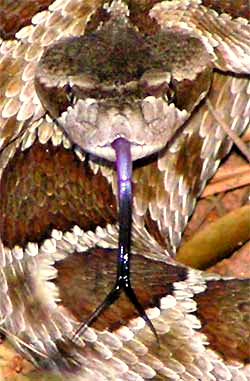from the September 4, 2005 Newsletter issued from the Sierra Nevada foothills
somewhat east of Placerville, California, USA
A WESTERN RATTLESNAKE

Photo by Andre Sage of Nevada
We looked at one another awhile, then he turned tail and fled, holding his tail high and rattling it, sounding very much like the small cicadas we have here, not the larger, very loudly droning cicadas of the East.
What a difference between this excitable, fast-moving Western Rattlesnake, CROTALUS OREGANUS, and the Timber Rattlers, CROTALUS HORRIDUS, I've met so often in the East! I'm used to Timber Rattlers lethargically lying quietly, even when they know they're discovered. Though I've relocated quite a number so people wouldn't hurt them, most of the time they've never even rattled. But this snake was a fast mover and he shook his tail as if his life depended on it.
Another difference between Timber Rattlers and Western Rattlers is that no subspecies of Timber Rattlers are recognized, while Western Rattlesnakes have fractured into eight subspecies in North America. When you consider the West's much more diverse landscape, that's understandable. Among the Western Rattlesnake's subspecies are the Prairie of the great grasslands, the Hopi of desert northeastern Arizona, and the high- elevation Great Basin Western Rattlers.
Here we're located on the boundary between two subspecies, with the Great Basin subspecies mostly higher up and the Northern Pacific subspecies mostly lower down, and my rattler moved so fast I couldn't figure out which subspecies he was.